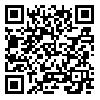Volume 19, Issue 4 (Vol.19, No.4, Winter 2024)
irje 2024, 19(4): 327-340 |
Back to browse issues page
Download citation:
BibTeX | RIS | EndNote | Medlars | ProCite | Reference Manager | RefWorks
Send citation to:



BibTeX | RIS | EndNote | Medlars | ProCite | Reference Manager | RefWorks
Send citation to:
Joghataei F, Roshanfekr P, Vameghi M, Jorjoran Shushtari Z, SoleimanvandiAzar N, Shirin Bayan P et al . Introducing Rapid Assessment and Response Approach in High-Risk Populations: A Review of Widely Used Guidelines. irje 2024; 19 (4) :327-340
URL: http://irje.tums.ac.ir/article-1-7262-en.html
URL: http://irje.tums.ac.ir/article-1-7262-en.html
Faezeh Joghataei1 
 , Payam Roshanfekr2
, Payam Roshanfekr2 
 , Meroe Vameghi3
, Meroe Vameghi3 
 , Zahra Jorjoran Shushtari4
, Zahra Jorjoran Shushtari4 
 , Neda SoleimanvandiAzar5
, Neda SoleimanvandiAzar5 
 , Peimaneh Shirin Bayan6
, Peimaneh Shirin Bayan6 
 , Gholamreza Ghaedamini Harouni *
, Gholamreza Ghaedamini Harouni * 
 7
7

 , Payam Roshanfekr2
, Payam Roshanfekr2 
 , Meroe Vameghi3
, Meroe Vameghi3 
 , Zahra Jorjoran Shushtari4
, Zahra Jorjoran Shushtari4 
 , Neda SoleimanvandiAzar5
, Neda SoleimanvandiAzar5 
 , Peimaneh Shirin Bayan6
, Peimaneh Shirin Bayan6 
 , Gholamreza Ghaedamini Harouni *
, Gholamreza Ghaedamini Harouni * 
 7
7
1- PhD Candidate in Social Welfare, Social Welfare Management Research Center, University of Social Welfare and Rehabilitation Sciences, Tehran, Iran
2- PhD in Social Determinants of Health (By Research), Social Welfare Management Research Center, University of Social Welfare and Rehabilitation Sciences, Tehran, Iran
3- Psychiatrist, Social Welfare Management Research Center, University of Social Welfare and Rehabilitation Sciences, Tehran, Iran
4- PhD in Social Determinants of Health (By Research), Social Determinants of Health Research Center, University of Social Welfare and Rehabilitation Sciences, Tehran, Iran
5- PhD in Social Welfare, Preventive Medicine and Public Health Research Center, Psychosocial Health Research Institute, Department of Community and Family Medicine, School of Medicine, Iran University of Medical Sciences, Tehran, Iran
6- PhD in Social Welfare, Pediatric Neurorehabilitation Research Center, Social Health Research Institute, University of Social Welfare and Rehabilitation Sciences, Tehran, Iran
7- PhD in Social Welfare, Social Welfare Management Research Center, University of Social Welfare and Rehabilitation Sciences, Tehran, Iran ,qaedamini@gmail.com
2- PhD in Social Determinants of Health (By Research), Social Welfare Management Research Center, University of Social Welfare and Rehabilitation Sciences, Tehran, Iran
3- Psychiatrist, Social Welfare Management Research Center, University of Social Welfare and Rehabilitation Sciences, Tehran, Iran
4- PhD in Social Determinants of Health (By Research), Social Determinants of Health Research Center, University of Social Welfare and Rehabilitation Sciences, Tehran, Iran
5- PhD in Social Welfare, Preventive Medicine and Public Health Research Center, Psychosocial Health Research Institute, Department of Community and Family Medicine, School of Medicine, Iran University of Medical Sciences, Tehran, Iran
6- PhD in Social Welfare, Pediatric Neurorehabilitation Research Center, Social Health Research Institute, University of Social Welfare and Rehabilitation Sciences, Tehran, Iran
7- PhD in Social Welfare, Social Welfare Management Research Center, University of Social Welfare and Rehabilitation Sciences, Tehran, Iran ,
Abstract: (64 Views)
Background and Objectives: Rapid Assessment and Response (RAR) is an approach that has been used in health research since the 1990s, and several guidelines have been designed for it. This study examines and compares different guidelines in this field.
Methods: This review study was conducted on the 6 guidelines published in PubMed and Scopus databases. After the initial review, the main dimensions of these guidelines, including the definition and target group, methods used, steps to conduct the research, and time planning were extracted in the form of a comparative table.
Results: In six guidelines, the RAR approach has been defined in relation to the comprehensive and rapid investigation of a health-related problem. There are differences in terms of the number of 'steps' of rapid assessment and response, as well as in 'time planning'; a period of 12 to 16 weeks is considered. Among the methods used in the reviewed guides, the following can be mentioned: reviewing available information, conducting interviews (open, structured, and semi-structured), focused group discussions, and other methods such as observation, surveys, narrative methods, and mapping.
Conclusion: The rapid assessment and response (RAR) can be used as an approach, with high flexibility and consideration of scientific and practical aspects, to assess health problems and high-risk behaviors in hard-to-reach groups.
Methods: This review study was conducted on the 6 guidelines published in PubMed and Scopus databases. After the initial review, the main dimensions of these guidelines, including the definition and target group, methods used, steps to conduct the research, and time planning were extracted in the form of a comparative table.
Results: In six guidelines, the RAR approach has been defined in relation to the comprehensive and rapid investigation of a health-related problem. There are differences in terms of the number of 'steps' of rapid assessment and response, as well as in 'time planning'; a period of 12 to 16 weeks is considered. Among the methods used in the reviewed guides, the following can be mentioned: reviewing available information, conducting interviews (open, structured, and semi-structured), focused group discussions, and other methods such as observation, surveys, narrative methods, and mapping.
Conclusion: The rapid assessment and response (RAR) can be used as an approach, with high flexibility and consideration of scientific and practical aspects, to assess health problems and high-risk behaviors in hard-to-reach groups.
Type of Study: Review Article |
Subject:
Special
Received: 2023/07/18 | Accepted: 2024/02/24 | Published: 2024/03/12
Received: 2023/07/18 | Accepted: 2024/02/24 | Published: 2024/03/12
Send email to the article author
| Rights and permissions | |
 |
This work is licensed under a Creative Commons Attribution-NonCommercial 4.0 International License. |



